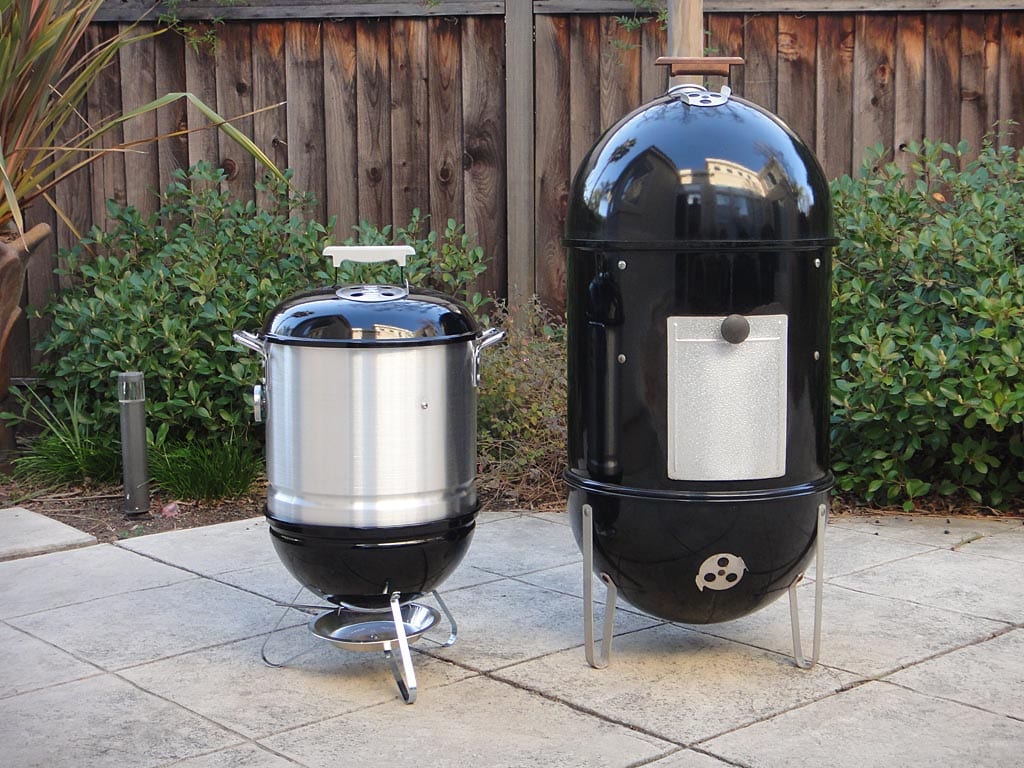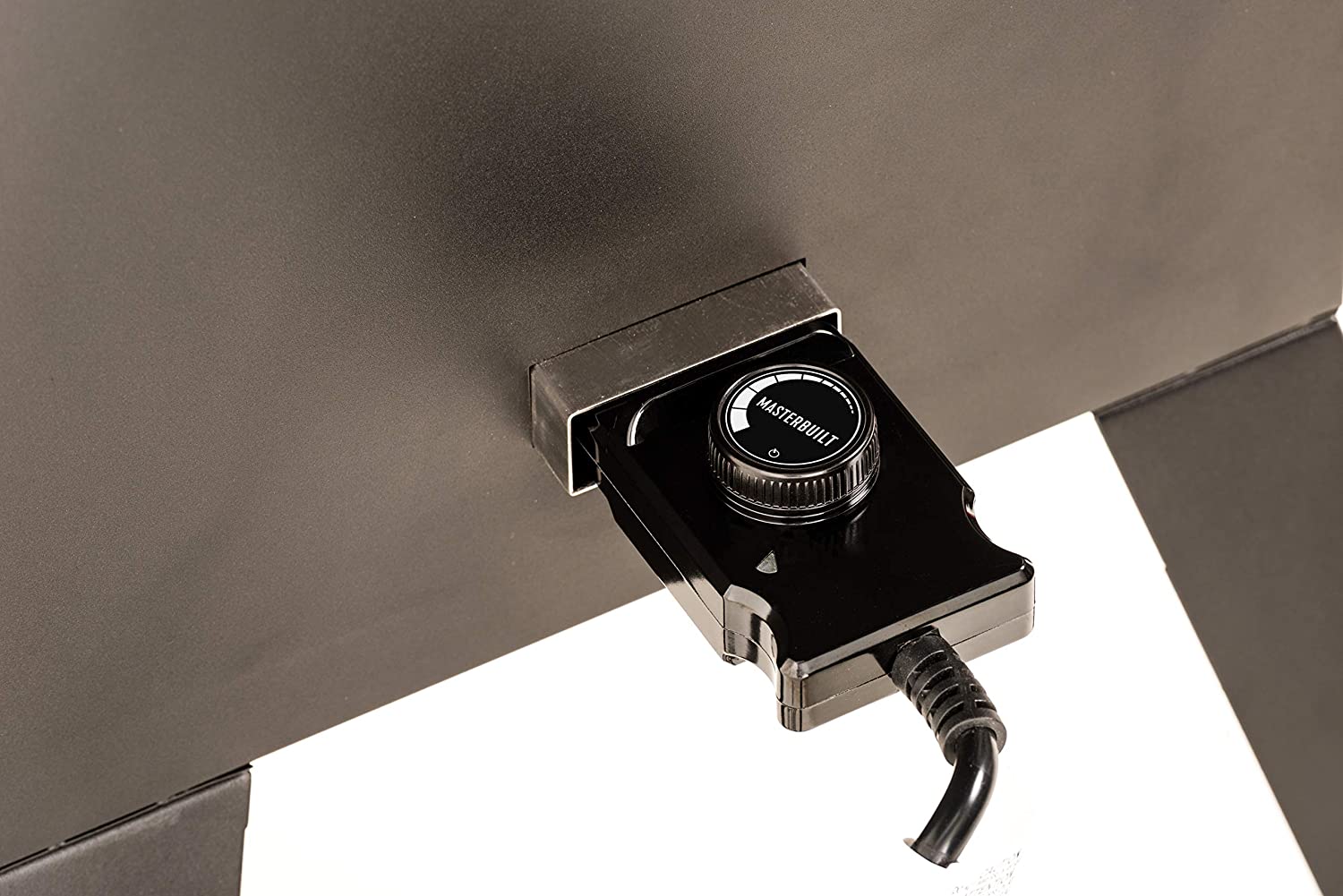After 1.5 years of procrastination I finally have a working implementation of an electric grill/smoker powered by ESPHome!
It all began when I saw the Alton Brown DIY flower pot smoker. Something like this:
I then saw the Weber Smokey Joe converted to a smoker with a tamale pot and I knew this is what I wanted.
But I haven’t seen anyone build this as an electric smoker so I decided that I would be the first.
I disassembled the counter-top burner and mounted the heating element to the charcoal grate, for the past year and a half I was using the smoker like this with the base of the electric burner outside of the grill. The temp control was terrible. The temp control seems to use a knob with a bi-metallic element that turns the grill on and off, and by removing the heating element the temp control got much worse.
I decided that it needed PID but I also wanted it integrated into Home Assistant. I went to the esphome webpage and found that there was no PID climate. I decided to start writing a custom climate implementation with PID but my c++ skills are not the best. This was during my last semester of my engineering degree so it got pushed to the back burner.
Every few months I would search to see if someone would beat me to making the PID climate and a few months ago it finally happened and made its way into the esphome beta build. My work got in the way of starting the implementation and soon enough, PID climate was pulled into the stable release. I was going to design a PCB but I got impatient so I used a ESP32 devkit C board and made this spaghetti monstrosity with all black wire that will soon be wrapped in electrical tape and hidden from the world.
After about a day of tuning IT WORKS! The system response could be a little better but I’m pretty happy. It will most likely also need two tuning profiles for grill an smoker mode.
This is the controller all closed up.
From left to right we have power in, power out, and the 4 temperature probes.
Where the burner coil is located.
For the grill temperature probe I use a Thermoworks High Temp Air Probe. Wood chips sit in a stainless pie pan on top of the burner coil.
Wiring and mounting of burner. Mounting uses no hardware. The metal bracket shown came as part of the coil, i ground it down so it would fit between the charcoal grate.
Smoker mode!
This schematic was originally going to turn in to a PCB with the ESP32 WROOM module soldered directly but I did not want to wait. All wiring is pretty much the same. The pins labeled Jack1-4 are for the switched 1/8 jacks to detect if a probe is connected. The same can be implemented in software since the voltage at the ADC will be 3.3V without a probe plugged in. I am also not using the exact SSR from the schematic, that was going to be PCB mounted but instead I used a common Fotek SSR.
esphome:
name: lil_smokey
platform: ESP32
board: nodemcu-32s
on_boot:
then:
- sensor.rotary_encoder.set_value:
id: rotary
value: 1
- switch.turn_on: ntc_vcc
wifi:
ssid: "nice try"
password: "wouldnt you like to know"
# Optional manual IP
manual_ip:
static_ip: nope
gateway: no way
subnet: kick rocks
# Enable fallback hotspot (captive portal) in case wifi connection fails
ap:
ssid: "Lil Smokey Fallback Hotspot"
password: "nuh uh"
captive_portal:
# Enable logging
logger:
# Enable Home Assistant API
api:
ota:
### Pull time from Home Assistant because everything needs a clock on it ###
time:
- platform: homeassistant
id: my_time
### Setup i2c for display and ADC ###
i2c:
sda: GPIO15
scl: GPIO4
switch:
### Power for Thermistors ###
- platform: gpio
pin: GPIO19
id: ntc_vcc
### Switches for Setting and Getting PID Values in Home Assistant ###
- platform: template
name: "PID Set"
turn_on_action:
- climate.pid.set_control_parameters:
id: pid_climate
kp: !lambda
return id(p_coefficient).state;
ki: !lambda
return id(i_coefficient).state;
kd: !lambda
return id(d_coefficient).state;
- platform: template
name: "Get PID Values"
turn_on_action:
- homeassistant.service:
service: input_number.set_value
data:
entity_id: input_number.p_coefficient
value: !lambda return id(kp).state;
- homeassistant.service:
service: input_number.set_value
data:
entity_id: input_number.i_coefficient
value: !lambda return id(ki).state;
- homeassistant.service:
service: input_number.set_value
data:
entity_id: input_number.d_coefficient
value: !lambda return id(kd).state;
### Switch to reset integral term for PID calculation ###
- platform: template
name: "Reset Integral"
turn_on_action:
- climate.pid.reset_integral_term: pid_climate
### Rotary Encoder Button - Some code to function as state machine - UNDER CONSTRUCTION ###
binary_sensor:
- platform: gpio
pin: GPIO21
id: encoder_button
filters:
- invert:
on_press:
then:
- if:
condition:
lambda: 'return id(edit);'
then:
- globals.set:
id: edit
value: "false"
- sensor.rotary_encoder.set_value:
id: rotary
value: !lambda |-
return id(current_page);
else:
- globals.set:
id: edit
value: "true"
- sensor.rotary_encoder.set_value:
id: rotary
value: 0
- display.page.show: !lambda |-
if (id(current_page)==1) {
return id(page11);
} if (id(current_page)==2) {
return id(page12);
} if (id(current_page)==3) {
return id(page13);
} if (id(current_page)==4) {
return id(page14);
} if (id(current_page)==5) {
return id(page15);
}
### Global Vars for OLED Menu State Retention ###
globals:
- id: edit
type: bool
initial_value: "false"
- id: current_page
type: int
initial_value: "1"
### PID Loop ###
climate:
- platform: pid
visual:
min_temperature: 150 °F
max_temperature: 525 °F
temperature_step: 1 °C
id: pid_climate
name: "Electric Grill"
sensor: temp1
default_target_temperature: 0°C
heat_output: heater
control_parameters:
kp: 0.037
ki: 0.0003
kd: 3
min_integral: 0
max_integral: 0.9
### Slow PWM for PID Output ###
output:
- platform: slow_pwm
pin: GPIO12
id: heater
period: 3s
### External Analog to Digital Converter Setup ###
ads1115:
- address: 0x48
sensor:
### Sensors to Read PID information into Home Assistant ###
- platform: pid
name: "PID Result"
type: RESULT
- platform: pid
name: "PID Integral Term"
type: INTEGRAL
- platform: pid
name: "PID Derivative Term"
type: DERIVATIVE
- platform: pid
name: "PID Proportional"
type: PROPORTIONAL
- platform: pid
name: "PID P Coefficient"
id: kp
type: KP
- platform: pid
name: "PID I Coefficient"
id: ki
type: KI
- platform: pid
name: "PID D Coefficient"
id: kd
type: KD
- platform: pid
name: "PID Output"
type: HEAT
### Sensors to read input numbers for PID tuning in Home Assistant ###
- platform: homeassistant
name: "P Coefficient"
entity_id: input_number.p_coefficient
id: p_coefficient
- platform: homeassistant
name: "I Coefficient"
entity_id: input_number.i_coefficient
id: i_coefficient
- platform: homeassistant
name: "D Coefficient"
entity_id: input_number.d_coefficient
id: d_coefficient
###-----------------------------------------------------------------------------------------------------###
### Temperature Sensing ###
###-----------------------------------------------------------------------------------------------------###
- platform: ntc
sensor: resistance_sensor
id: temp1
name: "temp1"
calibration:
b_constant: 3950
reference_temperature: 25°C
reference_resistance: 100kOhm
### Exponential filter to smooth temp readings to mitigate derivative term instability ###
filters:
- exponential_moving_average:
alpha: 0.09
send_every: 1
### Does voltage divider calculations to determine resistance of thermistor ###
- platform: resistance
id: resistance_sensor
sensor: adc1
configuration: DOWNSTREAM
resistor: 10000Ohm
filters:
### Custom filter to filter out obviously erraneous values ###
- lambda: |-
if (400000 >= x && 200<=x) return x;
else return {};
### Median filter to minimize influence of outlier values ###
- median:
window_size: 30
send_every: 1
### Reads voltage from External Analog to Digital Converter ###
- platform: ads1115
multiplexer: 'A0_GND'
gain: 4.096
id: adc1
### Might be able to read faster than this. Have not tried yet ###
update_interval: 0.75s
### Been working on temp control and signal filtetring. Will implement meat probes to display in home assistant and on display ###
# - platform: ads1115
# multiplexer: 'A1_GND'
# gain: 4.096
# id: adc2
# - platform: ads1115
# multiplexer: 'A2_GND'
# gain: 4.096
# id: adc3
# - platform: ads1115
# multiplexer: 'A3_GND'
# gain: 4.096
# id: adc4
###------------------------------------------------------------------------------###
### Rotary Encoder - Some code to function as state machine - UNDER CONSTRUCTION ###
###------------------------------------------------------------------------------###
- platform: rotary_encoder
id: rotary
pin_a: GPIO23
pin_b: GPIO22
on_value:
then:
- if:
condition:
lambda: 'return id(edit)==false;'
then:
- if:
condition:
lambda: 'return id(rotary).state > 5;'
then:
- sensor.rotary_encoder.set_value:
id: rotary
value: 1
- if:
condition:
lambda: 'return id(rotary).state < 1;'
then:
- sensor.rotary_encoder.set_value:
id: rotary
value: 5
- display.page.show: !lambda |-
if (id(rotary).state==1) {
return id(page1);
} if (id(rotary).state==2) {
return id(page2);
} if (id(rotary).state==3) {
return id(page3);
} if (id(rotary).state==4) {
return id(page4);
} if (id(rotary).state==5) {
return id(page5);
}
- globals.set:
id: current_page
value: !lambda |-
return id(rotary).state;
else:
- if:
condition:
lambda: 'return id(rotary).state == 1;'
then:
###-------------------------------------------------------------------###
### Display ###
###-------------------------------------------------------------------###
font:
- file: "chary.ttf"
id: font_14
size: 14
- file: "chary.ttf"
id: font_12
size: 12
image:
- file: "grill.png"
id: grill
resize: 24x24
- file: "meat.png"
id: meat
display:
- platform: ssd1306_i2c
model: "SSD1306 128x64"
id: oled
brightness: 1
### Originally set this entirely too fast. Got fast reponse from rotary encoder but caused frequent api disconnects and reconnects ###
update_interval: 0.5s
address: 0x3C
pages:
- id: page1
lambda: |-
if(true){
it.strftime(40, 0, id(font_14), "%I:%M%p", id(my_time).now());
}
it.print(5, 16, id(font_12), "Grill Temp");
it.printf(10, 34, id(font_14), "%.1f F", id(temp1).state* (9.0/5.0) + 32.0);
it.print(82, 16, id(font_12), "Mode");
it.line(5, 28, 64, 28);
it.line(80, 28, 105, 28);
- id: page2
lambda: |-
it.print(0, 10, id(font_14), "This is page 2!");
- id: page3
lambda: |-
it.print(0, 10, id(font_14), "This is page 3!");
- id: page4
lambda: |-
it.print(0, 10, id(font_14), "This is page 4!");
- id: page5
lambda: |-
it.print(0, 10, id(font_14), "This is page 5!");
- id: page11
lambda: |-
it.printf(0, 10, id(font_14), "This is %4.0f!", id(current_page)+id(rotary).state);
it.line(100, 10, 128, 10);
- id: page12
lambda: |-
it.print(0, 10, id(font_14), "This is page 2!");
- id: page13
lambda: |-
it.print(0, 10, id(font_14), "This is page 3!");
- id: page14
lambda: |-
it.print(0, 10, id(font_14), "This is page 4!");
- id: page15
lambda: |-
it.print(0, 10, id(font_14), "This is page 5!");
















